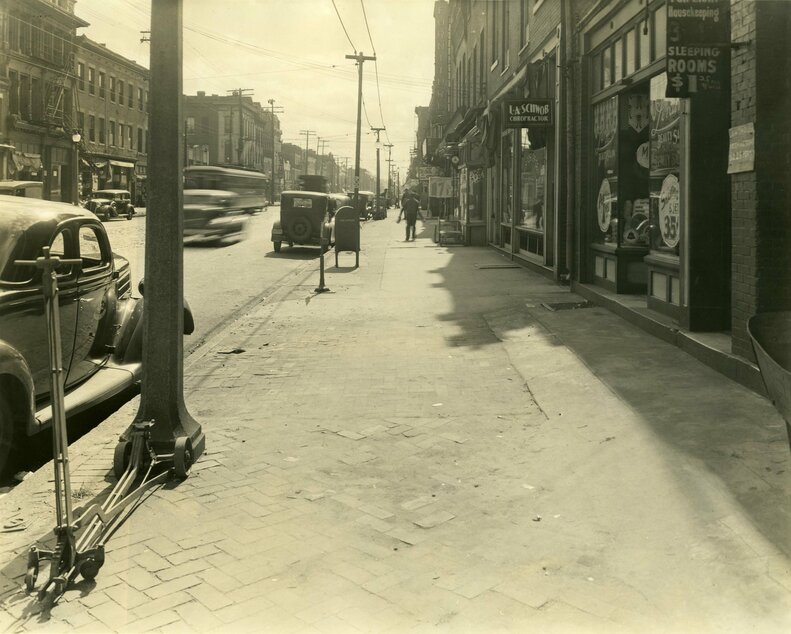
In the past two decades, the massive destruction of the African-American neighborhood Mill Creek has received more attention than it should. Kosciusko, a predominantly white neighborhood that lies between Seventh Street, Seventh Street, and the river stretch south of the MacArthur Bridge, was also destroyed by urban renewal in the 1960s. These same arguments that were used by city leaders against African Americans in Mill Creek were also used against poor white residents of Kosciusko and their aging homes and apartment buildings. They would surely live a better, more upright, and more respectable life if they moved to modernist public housing in the west. They would be freed from the vile-laden, soul-sucking rows of 19th-century houses that line the riverfront. The neighborhood would be transformed into a purely commercial and industrial district that is ready for investment.
However, if you have been reading my columns, you will be familiar with the following: photographs and records from Kosciusko show a vibrant and culturally rich community that has welcomed many immigrants to St. Louis. They often found work in the nearby industries and docks. Named Kosciusko Street after Andrzej Tadeusz Bonawentura Kosciuszko (a Polish patriot who fought in the American Revolution and returned to Poland in 1875). He unsuccessfully tried to preserve his country’s independence from Prussian, Russian, and Austrian imperialism. In 1875, Compton and Dry’s Pictorial St. Louis show a bustling community, with many industries, some more clean than others, and residential areas. Anheuser-Busch’s cooper shop (or barrel) was once located in the area.
The neighborhood was in danger of being demolished by the 1940s. It looks very similar to the Lower East Side in Manhattan, according to William Swekosky (a famous dentist and preservationist). Any urban planner would envy the South Broadway street wall, which formed the commercial district of the neighborhood. They were a bit rough around the edges but they are not unlike the Delmar Loop, Manchester at Maplewood, and Cherokee Street from the 1970s. Signs and other records show a diverse immigrant community consisting of Eastern European Jews, Croats, and other ethnicities that operate businesses along the artery. (An interesting aside, the broad traffic way that runs past Soulard Market is Seventh Boulevard and Broadway is one block east at this point in Kosciusko.
There were also churches. One of the most notable was Our Lady of Czestochowa. It is a small Polish Roman Catholic parish church located at the corner of Fourth Street and Victor Street. The original construction was done by German Lutherans in 1867 as a school, reflecting the large number of Protestants who emigrated from the region of Saxony. Over the years, Germans grew up in the middle class and moved westward into areas like Dutchtown. In 1907, Eastern European immigrants arrived in the area. The Roman Catholic Church purchased the building from a group of Polish Catholics, who had bought it from the German Lutherans the previous year. The second floor served as the sanctuary. Two classrooms were divided by a corridor on the first floor. The rectory next door was also built. It was still standing when the parish closed. Swekosky took Swekosky’s photograph of the complex. All its members had relocated west before “slum clearance”–before demolition.
Nearby was the John J. Roe & Co. meat packing plant. It was destroyed in 1954. Despite National City’s famed slaughterhouses, Roe’s plant was a successful business. Block 48 was the first building to be built in this area in 1859. It became a notorious spot in the city in the 19th century. The block was flooded by water from Mill Creek and sent porcine offal and waste into nearby streets. The City took the initiative to channel Mill Creek through the area, thanks to Ezra English (and others), who saved their investments.
John J. Roe was just right to get into the packing business since the Civil War demanded huge quantities of food for Union soldiers stationed in St. Louis. German shepherd dogs were used to transport the hogs from Gravois Avenue to the packing plant. We won’t go into detail about the horrific slaughter of the animals, as they were cruel to the bone. According to records, the sounds were heard all over the neighborhood. The packing plant is also associated with “Pigsfoot Alley”, an unsubstantiated story in St. Louis. Armour may have used every part of the hog, but Roe left the feet behind at the packing plant for anyone interested.


